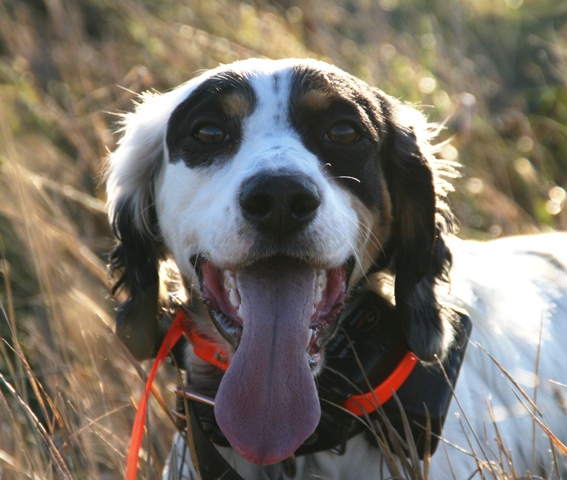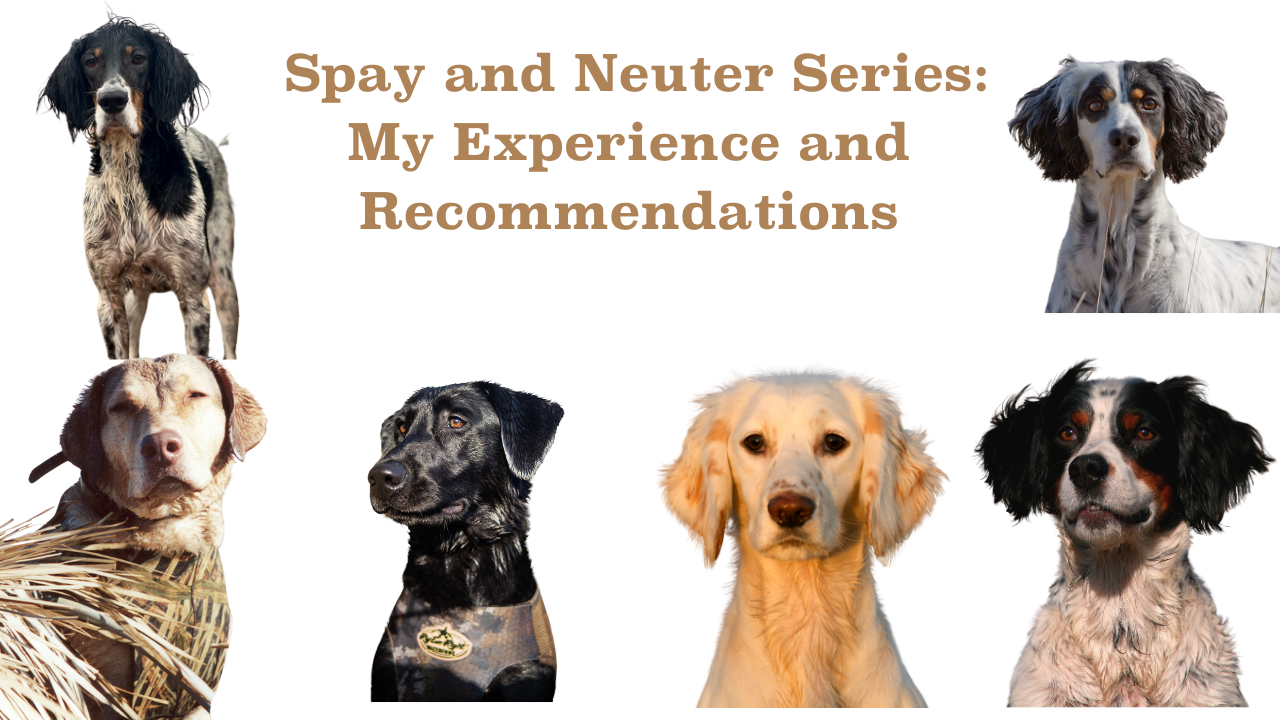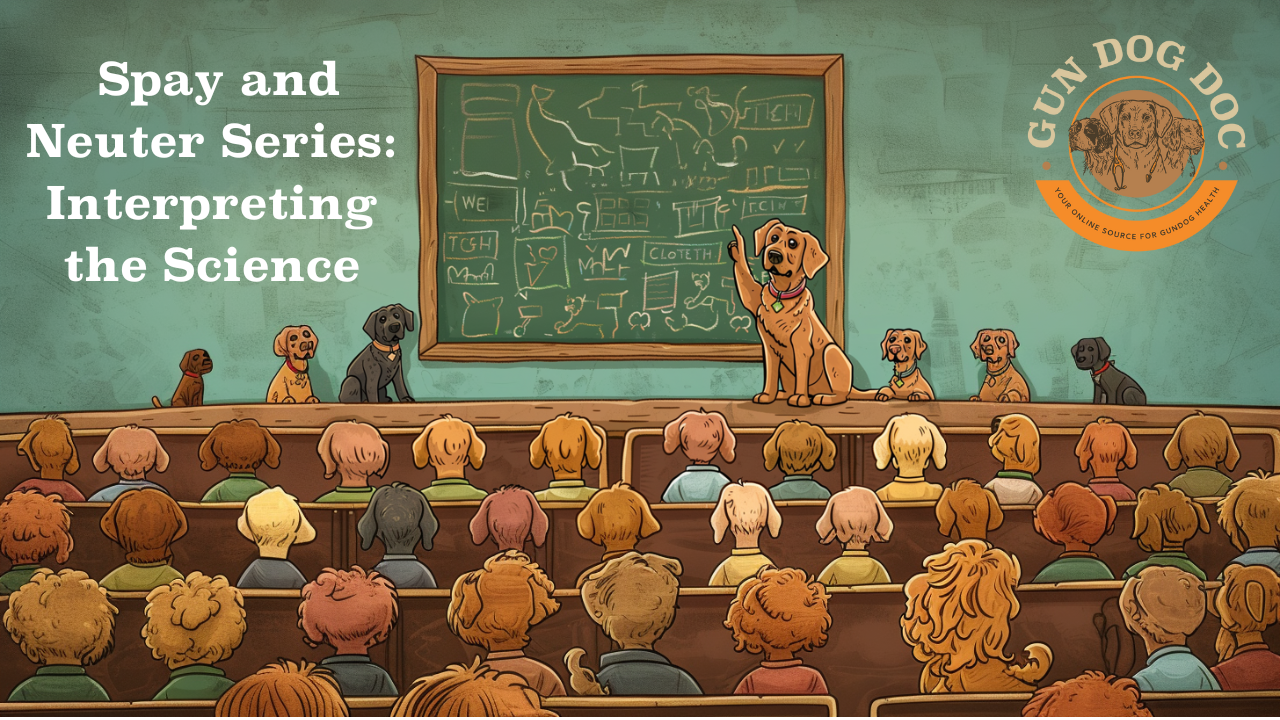One of the more frustrating cases we see in veterinary medicine is the case of an itchy dog—those dogs that are constantly battling skin infections, ear infections, or are just plain miserably itchy. For some dogs this is a very seasonal issue while for others it’s a year-round battle There are a number of things that can make a dog itchy, from bugs to behavior, but this article is going to address dogs with allergies, particularly inhalant allergies.
Unfortunately this is a very common problem in our beloved sporting breeds. Whether it be springers and cockers with chronic ear issues, labs with itchy skin, or goldens with their seasonal hotspots, there are very few breeds that are unrepresented with some form of allergies.
ALLERGIES IN A NUTSHELL
When you or I think of allergies in ourselves we think of things like hay-fever, asthma, sinus problems, etc. The same irritants that cause allergies in us can cause them in our pets. The difference is dogs most commonly get itchy and irritable skin instead of respiratory issues. Where this problem becomes even more of an annoyance is when this already irritated skin becomes infected.
Most people lump the common allergies in dogs into two major categories. The first type is inhalant which are allergies to various pollens, dusts (both outdoor and indoor), dander, etc. These dogs are typically itchy seasonally, and you can practically set your calendar by various bouts with ear infections, hotspots or excessive itching. Unfortunately for many dogs in this category a problem that started out seasonally will progress to being a year round issue. The other type is food allergy. Some dogs can develop an intestinal sensitivity to food, while others can develop an allergy to some component of the food that will show up as itchy, irritable skin. We will save the food allergy discussion for another day.
The most important thing to understand as an owner of an itchy dog is that this is a condition that will only be managed and likely never completely resolved. It is also extremely important to stay in touch with your veterinarian about the success, or lack thereof, of treatment protocols. During the initial stages of treatment you may need to schedule rechecks every 2-3 weeks to ensure infections are controlled and the symptoms are in check. Likely you have a dog that will either need some type of treatment for a large portion of the year. Too frequently we want to give a shot or a pill and have the problem go away, unfortunately with allergies that doesn’t always happen.
OK, so now you have the bad news, the good news is that often we can make these dogs much better, more comfortable, and in some cases, head off these annual issues.
ALLERGY DIAGNOSIS AND TREATMENT
The first place I start with these dogs is to determine if there are any secondary infections (i.e. ears, feet, skin), usually bacteria and/or yeast, and to diagnose and treat these before addressing the allergies. If you were going to rate an allergy dog on a scale of itchiness of 1 to 10, and let’s say your dog scores a 6, the same dog with secondary infections may be an 8, 9, or 10. Often times these infections are treated for 2-3 weeks with some combination of antibiotics, anti-fungals, and medicated shampoos. Depending on the individual case I will either begin management of the allergies in conjunction with the treatment of these infections or immediately following. The path we take will be determined how miserable the dog, or in some cases the owner, is due to the symptoms.
In this article I’ll address management of inhalant allergies in depth, and we’ll assume that if these options fail that the source of the problem is food, and the dog will need to undergo a diet trial of 6-8 weeks. I see a lot of people that attempt “diet trials” on their own, often incorrectly. During a true diet trial the dog will only be able to eat the prescribed diet—no treats, rawhides, table scraps and in some cases even no flavored medications I also would strongly encourage sticking with a veterinary diet, as many over-the-counter diets contain similar ingredients to one another, and although the bag may claim to be for sensitive skin, if the dog is truly food allergic it may not help in the least. Once a food allergy is confirmed then we can start experimenting with over-the-counter diets if so desired.
Inhalant Allergies
The aim of controlling inhalant allergies is to keep the skin from becoming irritated and prone to infections. Dogs will have varying levels of symptoms and our treatment options can be chosen in this manner as well. It’s important to note this because these issues are often a cascade meaning that they start mild and progress over the course of time. People often wait until the issues are severe to seek treatment and so our options are also then more limited, or need to be more aggressive, which often translates into more expensive. For those of you that follow on Instagram this fall I was quality of this with Boomer and his seasonal allergies flared at the start of hunting season which resulted in battling skin issues at the worst time possible.
Most of the time when instituted early, we can help alleviate progression with the the use of fatty acids and antihistamines. The market has become inundated with fatty acid products. My personal go to is a product called Welactin from Nutramax Laboratories. The biggest advice I can offer is to make sure you are using a product from a reputable manufacturer using quality ingredients. In a dog with true allergies, alone they likely will not be enough to control the problem, and that is why they are often used in conjunction with antihistamines. Antihistamines work well in people, but are often not as effective in dogs. Early in my career when our options were antihistamines or steroids I would do antihistamine trials having owners try 2-3 different options at 2-4 week intervals. Now, I try one, typically hydroxyzine (at some point most dogs have been on Benadryl so technically this would be a second trial). Again, there is no magic bullet…we are aiming for management and if the antihistamines don’t work we progress quickly to the newer options.
It’s funny I referenced a similar article I wrote for the original site over 20 years ago. At that time the next step in treatment was oral steroids and I had an entire disclaimer about “allergy shots” and how some veterinarians used a long-acting steroid as an allergy shot. Fast forward to today and we have a myriad of options including a true shot that is designed to modify the immune system to treat allergies.
When Apoquel came on the market it was as close to a silver bullet for allergies as we ever thought we would have. It is a drug that works by inhibiting a variety of cytokines involved in itchiness and inflammation. The drug was so popular when it first came out that there were several interruptions in supply and shortages that occurred. They seem to have gotten those issues sorted out and we have had a good supply for several years running now. Initially it truly did feel like a silver bullet as most dogs responded very well to the drug and side effects have been minimal. As we have used it more widely there certainly are some dogs whose allergies are not completely controlled on Apoquel.
Another option that was on the market prior to Apoquel is a drug called Atopica (cyclosporine). It is an immunosuppressive drug that was originally used to prevent organ rejection during organ transplants. The doses we use to treat allergies aren’t nearly at these levels. The most common side effect we see with this drug is vomiting issues. It is a very effective drug with the major pushback usually being cost for most owners, especially with larger dogs.
Recently another new drug has come on the market called Cytopoint. Cytopoint is an injection of a monoclonal antibody. It attaches to a specific cytokine, interleukin-31 which is involved in itchiness. I was initially a little skeptical since this was a new class of drug and we were starting to “tinker” with the immune system. It has been out for seven years now and I have been impressed with the response to the drug. Last fall I even used this in Boomer and if he has another end of summer flare-up I’ll be employing it sooner. The injections usually lasts from 4-8 weeks but in some dogs, like Boomer, it was a one and done situation.
Basically my standard approach is to still use Apoquel at initial presentation or in the management of most allergy cases and then use cytopoint in those dogs that are either not responding to the Apoquel or in dogs that have extended allergy season.
TAKE HOME POINTS
Essentially I’ve just scratched the surface of a very complex problem. Many times when an itchy dog comes in for its first visit, it will come with records from many veterinarians who the owner has become frustrated with because of a lack of a complete solution, and I have no doubt other veterinarians in town see former clients of mine who did not want to manage a problem but were hoping for a quick fix.
The key point is to understand these itchy dogs are frustrating from both sides of the exam table, because these are not normal dogs. And although it may not be what you want to hear, these are dogs with conditions that often will need to be managed for the rest of the dog’s life. Take an active role and try to find the best options for you hunting partner. Work with your veterinarian to find a treatment plan that works best for you and your dog’s situation.



